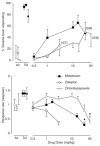Benzodiazepine-like discriminative stimulus effects of toluene vapor
- PMID: 24436974
- PMCID: PMC3934838
- DOI: 10.1016/j.ejphar.2013.10.036
Benzodiazepine-like discriminative stimulus effects of toluene vapor
Abstract
In vitro studies show that the abused inhalant toluene affects a number of ligand-gated ion channels.The two most consistently implicated of these are γ-aminobutyric acid type A(GABAA) receptors which are positively modulated by toluene and N-methyl-D-aspartate(NMDA) receptors which are negatively modulated by toluene. Behavioral studies also suggest an interaction of toluene with GABAA and/or NMDA receptors but it is unclear if these receptors underlie the abuse-related intoxicating effects of toluene. Seventeen B6SJLF1/J mice were trained using a two-choice operant drug discrimination procedure to discriminate 10 min of exposure to 2000 ppm toluene vapor from 10 min of exposure to air. The discrimination was acquired in a mean of 65 training sessions. The stimulus effects of 2000 ppm toluene vapor were exposure concentration-dependent but rapidly diminished following the cessation of vapor exposure. The stimulus effects of toluene generalized to the chlorinated hydrocarbon vapor perchloroethylene but not 1,1,2-trichloroethane nor the volatile anesthetic isoflurane. The competitive NMDA antagonist CGS-19755, the uncompetitive antagonist dizocilpine and the glycine-site antagonist L701,324 all failed to substitute for toluene. The classical nonselective benzodiazepines midazolam and chlordiazepoxide produced toluene-like stimulus effects but the alpha 1 subunit preferring positive GABAA modulator zaleplon failed to substitute for toluene. The barbiturates pentobarbital and methohexital and the GABAA positive modulator neurosteroid allopregnanolone did not substitute for toluene. These data suggest that the stimulus effects of toluene may be at least partially mediated by benzodiazepine-like positive allosteric modulation of GABAA receptors containing alpha 2, 3 or 5 subunits.
Figures


Similar articles
-
GABA(A) positive modulator and NMDA antagonist-like discriminative stimulus effects of isoflurane vapor in mice.Psychopharmacology (Berl). 2010 Dec;212(4):559-69. doi: 10.1007/s00213-010-1979-4. Epub 2010 Aug 10. Psychopharmacology (Berl). 2010. PMID: 20697696 Free PMC article.
-
GABAA-positive modulator selective discriminative stimulus effects of 1,1,1-trichloroethane vapor.Drug Alcohol Depend. 2012 Feb 1;121(1-2):103-9. doi: 10.1016/j.drugalcdep.2011.08.016. Epub 2011 Sep 15. Drug Alcohol Depend. 2012. PMID: 21924562 Free PMC article.
-
Pharmacological characterization of the discriminative stimulus of inhaled 1,1,1-trichloroethane.J Pharmacol Exp Ther. 2010 May;333(2):612-20. doi: 10.1124/jpet.109.158949. Epub 2010 Feb 1. J Pharmacol Exp Ther. 2010. PMID: 20123932 Free PMC article.
-
Discriminative Stimulus Effects of Abused Inhalants.Curr Top Behav Neurosci. 2018;39:113-139. doi: 10.1007/7854_2016_22. Curr Top Behav Neurosci. 2018. PMID: 27714629 Review.
-
Discriminative stimulus effects of ethanol: neuropharmacological characterization.Alcohol. 1999 Jan;17(1):63-80. doi: 10.1016/s0741-8329(98)00035-4. Alcohol. 1999. PMID: 9895039 Review.
Cited by
-
Negative allosteric modulation of GABAA receptors inhibits facilitation of brain stimulation reward by drugs of abuse in C57BL6/J mice.Psychopharmacology (Berl). 2016 Feb;233(4):715-25. doi: 10.1007/s00213-015-4155-z. Epub 2015 Nov 27. Psychopharmacology (Berl). 2016. PMID: 26612620 Free PMC article.
-
Preclinical characterization of toluene as a non-classical hallucinogen drug in rats: participation of 5-HT, dopamine and glutamate systems.Psychopharmacology (Berl). 2015 Oct;232(20):3797-808. doi: 10.1007/s00213-015-4041-8. Epub 2015 Aug 9. Psychopharmacology (Berl). 2015. PMID: 26255180
-
Discriminative stimulus properties of the atypical antipsychotic amisulpride: comparison to its isomers and to other benzamide derivatives, antipsychotic, antidepressant, and antianxiety drugs in C57BL/6 mice.Psychopharmacology (Berl). 2017 Dec;234(23-24):3507-3520. doi: 10.1007/s00213-017-4738-y. Epub 2017 Sep 18. Psychopharmacology (Berl). 2017. PMID: 28921163
-
Pharmacological classification of the abuse-related discriminative stimulus effects of trichloroethylene vapor.J Drug Alcohol Res. 2014 Mar 1;3:235839. doi: 10.4303/jdar/235839. J Drug Alcohol Res. 2014. PMID: 25202471 Free PMC article.
-
Stimulus mediation, specificity and impact of menthol in rats trained to discriminate puffs of nicotine e-cigarette aerosol from nicotine-free aerosol.Psychopharmacology (Berl). 2024 Aug;241(8):1527-1538. doi: 10.1007/s00213-024-06579-9. Epub 2024 Mar 23. Psychopharmacology (Berl). 2024. PMID: 38519818 Free PMC article.
References
-
- Bale AS, Meacham CA, Benignus VA, Bushnell PJ, Shafer TJ. Volatile organic compounds inhibit human and rat neuronal nicotinic acetylcholine receptors expressed in Xenopus oocytes. Toxicol Appl Pharmacol. 2005;205:77–88. - PubMed
-
- Balster RL. Neural basis of inhalant abuse. Drug Alcohol Depend. 1998;51:207–214. - PubMed
-
- Beckstead MJ, Phelan R, Mihic SJ. Antagonism of inhalant and volatile anesthetic enhancement of glycine receptor function. J Biol Chem. 2001;276:24959–24964. - PubMed
Publication types
MeSH terms
Substances
Grants and funding
LinkOut - more resources
Full Text Sources
Other Literature Sources

